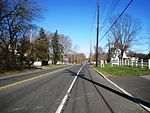Devitte Military Academy
The Devitte Military Academy was an American military academy founded in 1918 by Major Leopold Devitte and Suzanne Jacques DeVitte. It started as the "Devitte School" but changed its name in 1927. It closed in 1979.Starting out as co-educational residential school, in 1920, it became an all-male school. It was located on Wolleytown Road in the Morganville section of Marlboro Township, Monmouth County, New Jersey.At its start, the school campus covered about 70 acres. In 1931 it expanded to 80 acres. By 1974, the campus had been scaled back to 58 acres of "athletic and academic facilities".The school closed in 1943 but reopened in 1952.Most of the students were from the United States, Mexico and Central America.
Excerpt from the Wikipedia article Devitte Military Academy (License: CC BY-SA 3.0, Authors).Devitte Military Academy
Wooleytown Road,
Geographical coordinates (GPS) Address Nearby Places Show on map
Geographical coordinates (GPS)
| Latitude | Longitude |
|---|---|
| N 40.377845 ° | E -74.26154 ° |
Address
Wooleytown Road
07751
New Jersey, United States
Open on Google Maps




